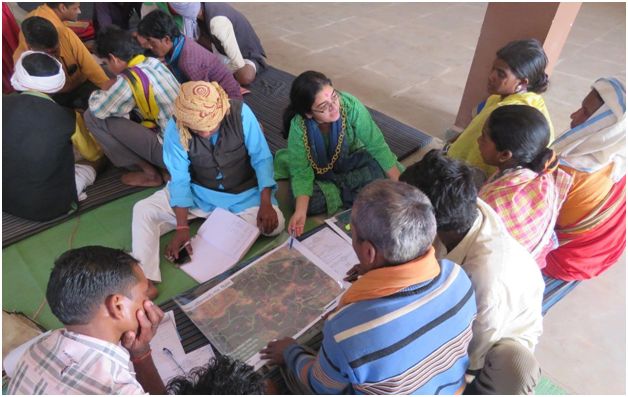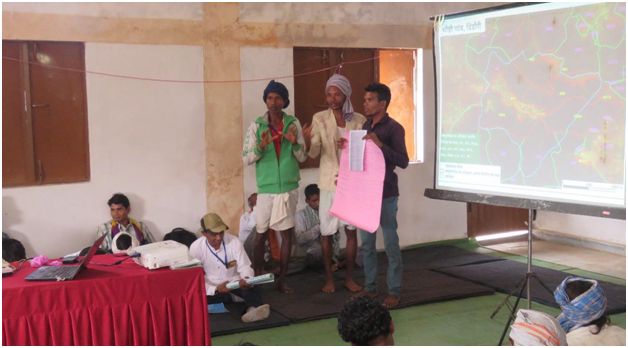Learning From and Carrying Forward CFR Management Planning in Central India, Revitalising CFR management in the Forest Villages of Baiga Chak, Madhya Pradesh
Revitalising CFR management in the Forest Villages of Baiga Chak, Madhya Pradesh
The Forest Villages of Baiga Chak in Dindori district of eastern Madhya Pradesh present sharp contrast to the forests of Bastar. Created by the colonial Forest Department itself to ensure labour for forestry operations in exchange for some agricultural land leases, the villagers still languish in the same condition even 75 years after independence , lacking secure cultivation rights and completely controlled by the forest administration. Although, thanks to their mobilisation and the support of NWYCID, a local rural development organisation, they received CFR rights (of sorts) back in 2010, they have been unable to exercise any of these rights thus far.
Last year, ATREE’s central India team member Venkat Ramanujam (whose doctoral work in Baiga Chak provided the foundation) initiated discussions with villagers on whether and how they want to take up CFR management. In the face of enthusiasm shown by the villagers, we approached the Collector Dindori, who extended his full support for conducting a CFR Management Planning workshop. This was held in Chada Forest Village’s community hall on 24th and 25th of March, with the help of Venkat, NYWCID’s Balwant Rahangdale and ATREE’s FRA coordinators (Sunaram, Sukkalsingh, Pitambar). These 5 villages were specifically chosen for the workshop as they have been making an active effort (for more than two decades!) to conserve their forest areas. After being introduced to the CFR management planning template, the 5 village teams worked to draft management plans for each of their villages. Some groups even worked late into the night and woke early in the morning to finish or improve their plans!

(Photo Credits: Venkat Ramanujam)
The following day, the representatives presented their draft management plans to district officials who attended the workshops, including the SDM Dindori, SDO Gadasarai, and representatives from the health and education departments. The presentations were followed by discussions with the officials on various issues pertaining to CFRR and IFR titles. The success of the workshops resulted in the District Collector of Dindori agreeing to initiate CFRR management planning pilots in the 5 villages that participated in the workshop.

While sharing our understanding based on observations and analysis of CFR management planning and progress in Maharashtra, we continue to learn more. First, that the ecological conditions significantly shape what is possible: Pachgaon has a large bamboo rich forest, while villages in Bastar have a limited bamboo resource and those in Baiga Chak have a forest heavily degraded by lantana invasion. Second, that communities will have to learn the ways and means of collective marketing and sale of non-timber forest products in the face of trader power, forest department vested interest and internal heterogeneity and lack of experience. They will sometimes fail and will have to be given the space to do so by a state providing a safety net and support, but not repeating the paternalistic approaches of the past. Third, people across all three states see the forest department’s timber-oriented ‘coupe felling’ is the biggest threat to a more people-friendly, NTFP-oriented and conservation-oriented forestry, both because the objectives of this ‘scientific forestry’ themselves are different from what people want and also because in practice, coupe felling results in the opening up of the forest canopy and the consequent invasion of lantana and other species that actually disrupt the ecology of the forest. Getting the foresters to change their mindsets and policies on coupe felling is going to be a major challenge.
The silver lining is that many villagers are both aware of these issues and interested in taking active measures to improve forest based livelihoods while conserving forest resources. Villagers are especially motivated to take up CFR management planning as a means to reducing if not stopping distress migration. Pachgaon inspires hope that improved livelihood prospects in the village will provide an incentive to stay for those who are forced to leave the village just to earn a living. Pachgaon also shows that villagers can sacrifice economic returns in the interest of conservation by setting aside devrais or sacred areas. The interest and motivation that exists at the village level encourages us to continue and expand this process of cross-learning.
These activities have been variously supported by the Bastar District Administration, AJWS, and UUA.


